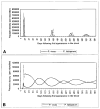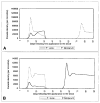Blood-stage dynamics and clinical implications of mixed Plasmodium vivax-Plasmodium falciparum infections
- PMID: 10497972
- PMCID: PMC2483693
- DOI: 10.4269/ajtmh.1999.61.367
Blood-stage dynamics and clinical implications of mixed Plasmodium vivax-Plasmodium falciparum infections
Abstract
We present a mathematical model of the blood-stage dynamics of mixed Plasmodium vivax-Plasmodium falciparum malaria infections in humans. The model reproduces features of such infections found in nature and suggests several phenomena that may merit clinical attention, including the potential recrudescence of a long-standing, low-level P. falciparum infection following a P. vivax infection or relapse and the capacity of an existing P. vivax infection to reduce the peak parasitemia of a P. falciparum superinfection. We simulate the administration of antimalarial drugs, and illustrate some potential complications in treating mixed-species malaria infections. Notably, our model indicates that when a mixed-species infection is misdiagnosed as a single-species P. vivax infection, treatment for P. vivax can lead to a surge in P. falciparum parasitemia.
Figures





References
Publication types
MeSH terms
Substances
Grants and funding
LinkOut - more resources
Full Text Sources

